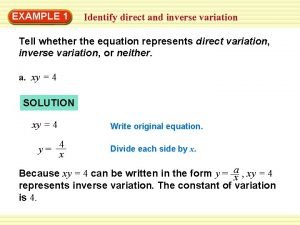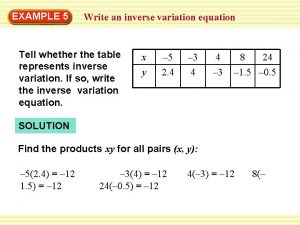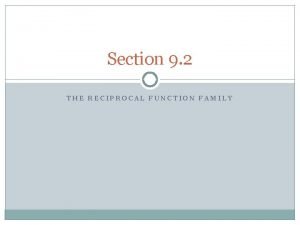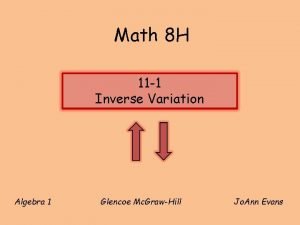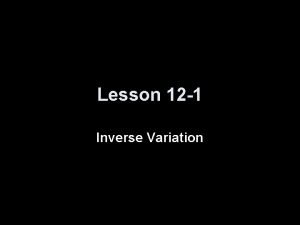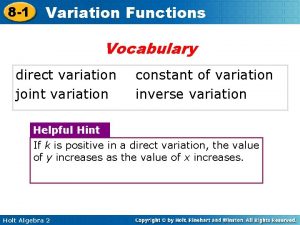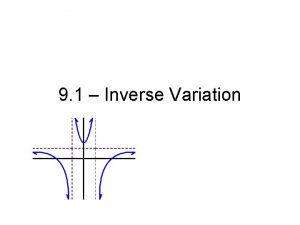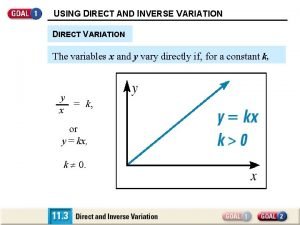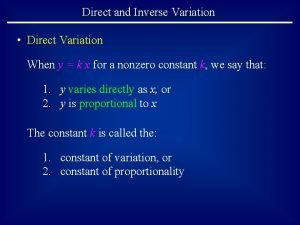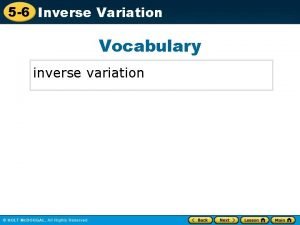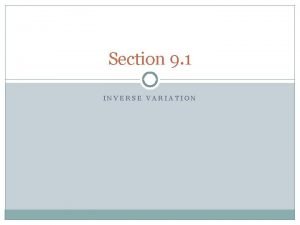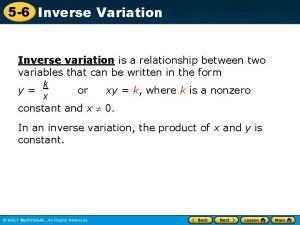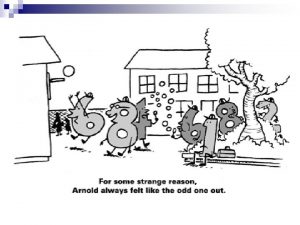USING DIRECT AND INVERSE VARIATION DIRECT VARIATION The













- Slides: 13

USING DIRECT AND INVERSE VARIATION DIRECT VARIATION The variables x and y vary directly if, for a constant k, y = k, x or y = kx, k 0.

USING DIRECT AND INVERSE VARIATION INDIRECT VARIATION The variables x and y vary inversely, if for a constant k, k = y, x or xy = k, k 0.

USING DIRECT AND INVERSE VARIATION MODELS FOR DIRECT AND INVERSE VARIATION DIRECT VARIATION y = kx k>0 INVERSE VARIATION k y = x k>0

Using Direct and Inverse Variation When x is 2, y is 4. Find an equation that relates x and y in each case. x and y vary directly SOLUTION Write direct variation model. Substitute 2 for x and 4 for y. Simplify. y An equation that relates x and y is = 2, or y = 2 x. x

Using Direct and Inverse Variation When x is 2, y is 4. Find an equation that relates x and y in each case. x and y vary inversely SOLUTION Write inverse variation model. Substitute 2 for x and 4 for y. 8=k Simplify. An equation that relates x and y is xy = 8, or y = 8. x

Comparing Direct and Inverse Variation Compare the direct variation model and the inverse variation model you just found using x = 1, 2, 3, and 4. SOLUTION Make a table using y = 2 x and y = x 8. x 1 2 3 4 Direct Variation: k > 0. As x increases by 1, y increases by 2. y = 2 x 2 4 6 8 Inverse Variation: k > 0. As x doubles (from 1 to 2), y is halved (from 8 to 4). y = x 8 8 4 8 3 2

Comparing Direct and Inverse Variation Compare the direct variation model and the inverse variation model you just found using x = 1, 2, 3, and 4. SOLUTION Plot the points and then connect the points with a smooth curve. Direct Variation: the graph for this model is a line passing through the origin. Inverse Variation: The graph for this model is a curve that gets closer and closer to the x-axis as x increases and closer to the y-axis as x gets close to 0. Direct y = 2 x Inverse y = x 8

USING DIRECT AND INVERSE VARIATION IN REAL LIFE Writing and Using a Model BICYCLING A bicyclist tips the bicycle when making turn. The angle B of the bicycle from the vertical direction is called the banking angle, B

Writing and Using a Model BICYCLING The graph below shows a model for the relationship between the banking angle and the turning radius for a bicycle traveling at a particular speed. For the values shown, the banking angle B and the turning radius r vary inversely. Banking angle (degrees) r turning radius Turning Radius banking angle, B

Writing and Using a Model Banking angle (degrees) r turning radius Turning Radius banking angle, B Find an inverse variation model that relates B and r. Use the model to find the banking angle for a turning radius of 5 feet. Use the graph to describe how the banking angle changes as the turning radius gets smaller.

Find an inverse variation model that relates B and r. SOLUTION From the graph, you can see that B = 32° when r = 3. 5 feet. k B= r k 32 = 3. 5 112 = k The model is B = Banking angle (degrees) Writing and Using a Model Turning Radius Write direct variation model. Substitute 32 for B and 3. 5 for r. Solve for k. 112 , where B is in degrees and r is in feet. r

Use the model to find the banking angle for a turning radius of 5 feet. Banking angle (degrees) Writing and Using a Model Turning Radius SOLUTION Substitute 5 for r in the model you just found. 112 = 22. 4 B= 5 When the turning radius is 5 feet, the banking angle is about 22°.

Writing and Using a Model Use the graph to describe how the banking angle changes as the turning radius gets smaller. SOLUTION As the turning radius gets smaller, thebankingangle becomes greater. Thebicyclistleansatatgreaterangles. Notice that the increase in the banking angle becomes more rapid when the turning radius is small.
 Inverse eq
Inverse eq How to identify direct and inverse variation
How to identify direct and inverse variation Which of these graphs is the graph of an inverse variation
Which of these graphs is the graph of an inverse variation What is the difference between direct and inverse variation
What is the difference between direct and inverse variation Direct vs inverse variation
Direct vs inverse variation Direct variation equation
Direct variation equation Inverse variation and the reciprocal function
Inverse variation and the reciprocal function Inverse variation parent function
Inverse variation parent function Correlation and regression
Correlation and regression 11-1 inverse variation answers
11-1 inverse variation answers Inverse variations examples
Inverse variations examples Variation functions
Variation functions 6-7 inverse relations and functions
6-7 inverse relations and functions Inverse variation proportion
Inverse variation proportion

